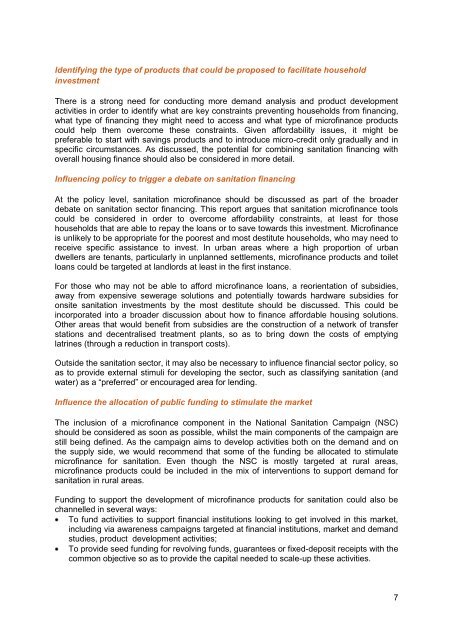REPORT__Evaluating_the_potential_of_microfinance_for_sanitation_in_Tanzania_May_2013
REPORT__Evaluating_the_potential_of_microfinance_for_sanitation_in_Tanzania_May_2013
REPORT__Evaluating_the_potential_of_microfinance_for_sanitation_in_Tanzania_May_2013
Create successful ePaper yourself
Turn your PDF publications into a flip-book with our unique Google optimized e-Paper software.
Identify<strong>in</strong>g <strong>the</strong> type <strong>of</strong> products that could be proposed to facilitate household<br />
<strong>in</strong>vestment<br />
There is a strong need <strong>for</strong> conduct<strong>in</strong>g more demand analysis and product development<br />
activities <strong>in</strong> order to identify what are key constra<strong>in</strong>ts prevent<strong>in</strong>g households from f<strong>in</strong>anc<strong>in</strong>g,<br />
what type <strong>of</strong> f<strong>in</strong>anc<strong>in</strong>g <strong>the</strong>y might need to access and what type <strong>of</strong> micr<strong>of</strong><strong>in</strong>ance products<br />
could help <strong>the</strong>m overcome <strong>the</strong>se constra<strong>in</strong>ts. Given af<strong>for</strong>dability issues, it might be<br />
preferable to start with sav<strong>in</strong>gs products and to <strong>in</strong>troduce micro-credit only gradually and <strong>in</strong><br />
specific circumstances. As discussed, <strong>the</strong> <strong>potential</strong> <strong>for</strong> comb<strong>in</strong><strong>in</strong>g <strong>sanitation</strong> f<strong>in</strong>anc<strong>in</strong>g with<br />
overall hous<strong>in</strong>g f<strong>in</strong>ance should also be considered <strong>in</strong> more detail.<br />
Influenc<strong>in</strong>g policy to trigger a debate on <strong>sanitation</strong> f<strong>in</strong>anc<strong>in</strong>g<br />
At <strong>the</strong> policy level, <strong>sanitation</strong> micr<strong>of</strong><strong>in</strong>ance should be discussed as part <strong>of</strong> <strong>the</strong> broader<br />
debate on <strong>sanitation</strong> sector f<strong>in</strong>anc<strong>in</strong>g. This report argues that <strong>sanitation</strong> micr<strong>of</strong><strong>in</strong>ance tools<br />
could be considered <strong>in</strong> order to overcome af<strong>for</strong>dability constra<strong>in</strong>ts, at least <strong>for</strong> those<br />
households that are able to repay <strong>the</strong> loans or to save towards this <strong>in</strong>vestment. Micr<strong>of</strong><strong>in</strong>ance<br />
is unlikely to be appropriate <strong>for</strong> <strong>the</strong> poorest and most destitute households, who may need to<br />
receive specific assistance to <strong>in</strong>vest. In urban areas where a high proportion <strong>of</strong> urban<br />
dwellers are tenants, particularly <strong>in</strong> unplanned settlements, micr<strong>of</strong><strong>in</strong>ance products and toilet<br />
loans could be targeted at landlords at least <strong>in</strong> <strong>the</strong> first <strong>in</strong>stance.<br />
For those who may not be able to af<strong>for</strong>d micr<strong>of</strong><strong>in</strong>ance loans, a reorientation <strong>of</strong> subsidies,<br />
away from expensive sewerage solutions and <strong>potential</strong>ly towards hardware subsidies <strong>for</strong><br />
onsite <strong>sanitation</strong> <strong>in</strong>vestments by <strong>the</strong> most destitute should be discussed. This could be<br />
<strong>in</strong>corporated <strong>in</strong>to a broader discussion about how to f<strong>in</strong>ance af<strong>for</strong>dable hous<strong>in</strong>g solutions.<br />
O<strong>the</strong>r areas that would benefit from subsidies are <strong>the</strong> construction <strong>of</strong> a network <strong>of</strong> transfer<br />
stations and decentralised treatment plants, so as to br<strong>in</strong>g down <strong>the</strong> costs <strong>of</strong> empty<strong>in</strong>g<br />
latr<strong>in</strong>es (through a reduction <strong>in</strong> transport costs).<br />
Outside <strong>the</strong> <strong>sanitation</strong> sector, it may also be necessary to <strong>in</strong>fluence f<strong>in</strong>ancial sector policy, so<br />
as to provide external stimuli <strong>for</strong> develop<strong>in</strong>g <strong>the</strong> sector, such as classify<strong>in</strong>g <strong>sanitation</strong> (and<br />
water) as a “preferred” or encouraged area <strong>for</strong> lend<strong>in</strong>g.<br />
Influence <strong>the</strong> allocation <strong>of</strong> public fund<strong>in</strong>g to stimulate <strong>the</strong> market<br />
The <strong>in</strong>clusion <strong>of</strong> a micr<strong>of</strong><strong>in</strong>ance component <strong>in</strong> <strong>the</strong> National Sanitation Campaign (NSC)<br />
should be considered as soon as possible, whilst <strong>the</strong> ma<strong>in</strong> components <strong>of</strong> <strong>the</strong> campaign are<br />
still be<strong>in</strong>g def<strong>in</strong>ed. As <strong>the</strong> campaign aims to develop activities both on <strong>the</strong> demand and on<br />
<strong>the</strong> supply side, we would recommend that some <strong>of</strong> <strong>the</strong> fund<strong>in</strong>g be allocated to stimulate<br />
micr<strong>of</strong><strong>in</strong>ance <strong>for</strong> <strong>sanitation</strong>. Even though <strong>the</strong> NSC is mostly targeted at rural areas,<br />
micr<strong>of</strong><strong>in</strong>ance products could be <strong>in</strong>cluded <strong>in</strong> <strong>the</strong> mix <strong>of</strong> <strong>in</strong>terventions to support demand <strong>for</strong><br />
<strong>sanitation</strong> <strong>in</strong> rural areas.<br />
Fund<strong>in</strong>g to support <strong>the</strong> development <strong>of</strong> micr<strong>of</strong><strong>in</strong>ance products <strong>for</strong> <strong>sanitation</strong> could also be<br />
channelled <strong>in</strong> several ways:<br />
To fund activities to support f<strong>in</strong>ancial <strong>in</strong>stitutions look<strong>in</strong>g to get <strong>in</strong>volved <strong>in</strong> this market,<br />
<strong>in</strong>clud<strong>in</strong>g via awareness campaigns targeted at f<strong>in</strong>ancial <strong>in</strong>stitutions, market and demand<br />
studies, product development activities;<br />
To provide seed fund<strong>in</strong>g <strong>for</strong> revolv<strong>in</strong>g funds, guarantees or fixed-deposit receipts with <strong>the</strong><br />
common objective so as to provide <strong>the</strong> capital needed to scale-up <strong>the</strong>se activities.<br />
7


